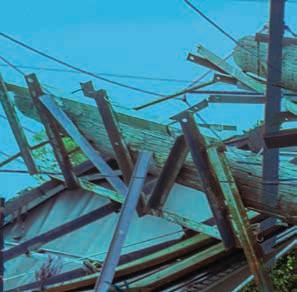
3 minute read
GENERATOR SAFETY
Never connect a generator directly to your home’s wiring without a Generlink or other approved interconnect device. Power from a generator connected to a home’s wiring will “back feed” into utility lines and could seriously hurt power crews working to restore service.
Plug appliances directly into the generator’s outlet.
Don’t leave a running generator unattended; turn it off at night and when away from home. Never refuel a hot generator or one that is running; hot engine parts or exhaust can ignite gasoline. Turn off all connected appliances before starting your generator.
Turn connected appliances on one at a time, never exceeding the generator’s rated wattage. Overloading the generator can result in damage to appliances it is powering.
Remember, gasoline-powered generators produce deadly carbon monoxide fumes. Never run generators inside, in a garage, or any enclosed or partially enclosed areas. You cannot see or smell carbon monoxide (CO), and portable generators can produce high levels of the toxic gas very quickly.
Keep generators away from all open windows — including neighbors’ windows — so deadly exhaust (CO) does not enter their home or business. To be safe, buy a battery-operated carbon-monoxide alarm when you buy your generator. It works like a smoke alarm, sounding an alert if carbon monoxide levels become dangerous.
By Keys Weekly staff
What To Know With Your
The following tips from the Florida Keys Aqueduct Authority will ensure you have a supplemental water supply, minimize damages and expedite recovery. For more information, visit fkaa.com or call 305-296-2454.
EVACUATING? HERE’S WHAT TO DO
Shut off the home’s water valve (typically found on the exterior wall of the home). Some water heaters may also need to be shut off. Check with the manufacturer. Customers with a low pressure sewer system pump on their property are asked to shut off the breaker to their grinder pump (located in the dedicated electric box outside of the home).
Water Storage
For drinking and cooking, save enough water for seven to 10 days. Fill the bathtub and containers with water for non-drinking purposes.
WATCH FOR PRECAUTIONARY/ MANDATORY BOIL WATER NOTICES
If a notice is issued, disinfect your water by either boiling for one minute, adding one-eighth teaspoon of bleach per gallon or using purification tablets (purchase at outdoor retailers).
Stay Informed
Follow the Florida Keys Aqueduct Authority on Facebook and visit fkaa. com. Register for priority calls at fkaa. com to receive neighborhood specific notices via phone, text and email.
By Keys Weekly staff
Storm surge from a hurricane is often the greatest threat to life and property along the coast. If history tells us anything, many deaths from major hurricanes have resulted from the rise of the ocean due to storm surge.
Hurricane Katrina, which hit New Orleans in 2005, is a prime example of the damage and destruction caused by the surge. Around 1,500 people lost their lives during Katrina and many of those deaths occurred directly and indirectly from storm surge.
During Hurricane Ian in 2022, storm surge pushed 15 feet of water from the Gulf of Mexico to the normally dry areas of Fort Myers, Florida.
WHAT’S THE DIFFERENCE BETWEEN STORM SURGE & STORM TIDE?
Per the National Hurricane Center, storm surge is the abnormal rise of water that’s generated by a storm over and above the predicted astronomical tides. Storm tide is defined as the water level rise due to the combination of storm surge and astronomical tide.
WHAT INFLUENCES SURGE?
The larger the storm, the higher the surge. This is because stronger winds from a larger storm are pushing on a larger area of the ocean. And those winds will stay around longer due to the storm’s size. The angle in which a storm approaches a coastline, winds and slope of the ocean bottom and coastline shape are other factors that contribute to surge from a given storm. On the open coast, a faster storm will produce a higher surge. And higher surge is produced in bays, sounds and other enclosed bodies of water with a slower storm.
WHAT SHOULD I WATCH OUT FOR?
Look out for storm surge watches and warnings. A storm surge watch indicates the possibility of life-threatening, rising water moving inland from the shoreline within a specified area, generally within 48 hours of a storm’s arrival. The watch may be issued earlier when other conditions, such as the onset of tropical storm-force winds, are expected to limit the time available to take protective actions for surge (e.g., evacuations).
A storm surge warning is the likelihood of life-threatening water that’s rising and moving inland from the shoreline within a specified area within 36 hours of a storm’s arrival. A warning could be issued earlier when other conditions such as the onset of tropical storm force winds are expected to limit the time available to take protective actions for surge, like evacuations.
HOW DO I RESPOND TO STORM SURGE ?
Storm surge evacuation orders from local emergency management officials should be heeded immediately. Storm surges can cause water to rise quickly.
Heed watches and warnings






